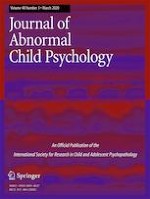05-12-2019
Emotion Regulation via the Autonomic Nervous System in Children with Attention-Deficit/Hyperactivity Disorder (ADHD): Replication and Extension
Gepubliceerd in: Research on Child and Adolescent Psychopathology | Uitgave 3/2020
Log in om toegang te krijgenAbstract
Attention-deficit/hyperactivity disorder (ADHD) is a prevalent disorder characterized by symptoms of inattention, hyperactivity, and/or impulsivity, as well as executive dysfunction. Recent work underlines the importance in understanding the role of emotion reactivity and regulatory deficits in the context of the disorder. One study (i.e., Musser et al. 2011) utilized a positive and negative emotion induction and suppression task, as well as indexes of autonomic nervous system reactivity, to examine emotional functioning in youth with ADHD. This study revealed inflexible parasympathetic-based regulation across emotion conditions among youth with ADHD compared to typically developing youth. The present study sought to replicate and extend these findings to a clinically recruited, diverse sample, while also examining sympathetic functioning. Two hundred fifty-nine participants (160 youth with ADHD), aged 5 to 13, completed the task utilized in Musser et al. 2011, while indexes of parasympathetic (i.e., respiratory sinus arrhythmia [RSA]) and sympathetic (i.e., pre-ejection period [PEP] and electrodermal activity [EDA]) reactivity were obtained. ADHD was associated with significantly elevated parasympathetic (i.e., augmented RSA) and sympathetic (as indexed by EDA) reactivity. Overall, results replicate and extend Musser et al. 2011, revealing sympathetic-linked disruptions in emotion reactivity and parasympathetic-linked disruptions in emotion regulation among youth with ADHD. Future studies of behavioral therapies for ADHD should consider the efficacy of adding an emotion regulation skills training component.
